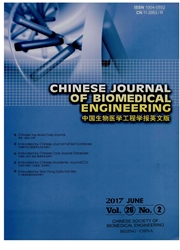

 中文摘要:
中文摘要:
To make clear the precise hemodynamic mechanism underlying the anti-atherogenesis benefit of enhanced external couterpulsation(EECP) treatment, and to investigate the proper role of some important hemodynamic factors during the atherosclerotic progress, a comprehensive study combining long-term animal experiment and numerical solving was conducted in this paper. An experimentally induced hypercholesterolemic porcine model was developed and the chronic EECP intervention was subjected. Basic hemodynamic measurement was performed in vivo, as well as the arterial endothelial samples were extracted for physiological examination. Meanwhile, a numerical model was introduced to solve the complex hemodynamic factors such as WSS and OSI. The results show that EECP treatment resulted in significant increase of the instant levels of arterial WSS, blood pressure, and OSI. During EECP treatment, the instant OSI level of the common carotid arteries over cardiac cycles raised to a mean value of 8.58 ×10-2±2.13 ×10-2. Meanwhile, the chronic intervention of EECP treatment significantly reduced the atherosclerotic lesions in abdominal aortas and the endothelial cellular adherence. The present study suggests that the unique blood flow pattern induced by EECP treatment and the augmentation of WSS level in cardiac cycles may be the most important hemodynamic mechanism that contribute to its anti-atherogenesis effect. And as one of the indices that cause great concern in current hemodynamic study, OSI may not play a key role during the initiation of atherosclerosis.更多还原
 英文摘要:
英文摘要:
To make clear the precise hemodynamic mechanism underlying the anti-atherogenesis benefit of enhanced external couterpulsation(EECP) treatment, and to investigate the proper role of some important hemodynamic factors during the atherosclerotic progress, a comprehensive study combining long-term animal experiment and numerical solving was conducted in this paper. An experimentally induced hypercholesterolemic porcine model was developed and the chronic EECP intervention was subjected. Basic hemodynamic measurement was performed in vivo, as well as the arterial endothelial samples were extracted for physiological examination. Meanwhile, a numerical model was introduced to solve the complex hemodynamic factors such as WSS and OSI. The results show that EECP treatment resulted in significant increase of the instant levels of arterial WSS, blood pressure, and OSI. During EECP treatment, the instant OSI level of the common carotid arteries over cardiac cycles raised to a mean value of 8.58 × 10-2 ±2.13 ×10-2. Meanwhile, the chronic intervention of EECP treatment significantly reduced the atherosclerotic lesions in abdominal aortas and the endothelial cellular adherence. The present study suggests that the unique blood flow pattern induced by EECP treatment and the augmentation of WSS level in cardiac cycles may be the most important hemodynamic mechanism that contribute to its anti-atherogenesis effect. And as one of the indices that cause great concern in current hemodynamic study, OSI may not play a key role during the initiation of atherosclerosis.
 同期刊论文项目
同期刊论文项目
 同项目期刊论文
同项目期刊论文
 期刊信息
期刊信息
